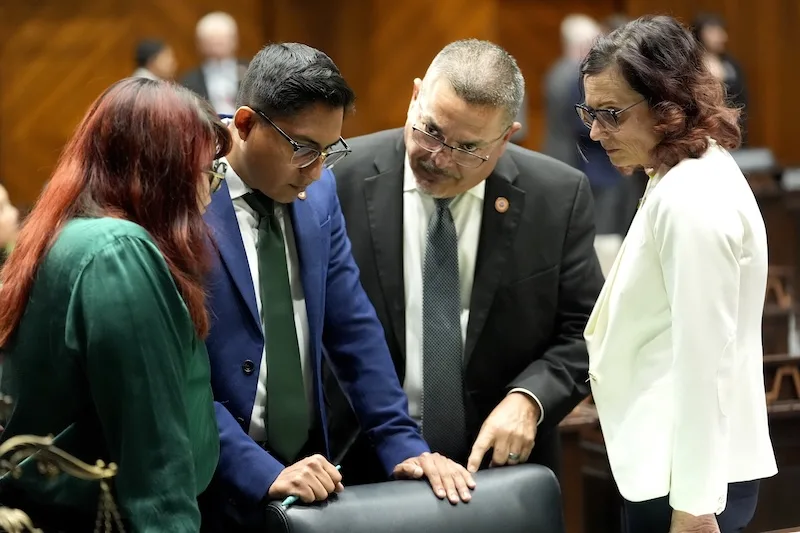
A 42-year-old amendment to Arizona’s constitution is proving to have dire effects on the state’s public school system.
Arizona’s chronically underfunded public school system could be at a tipping point, as some lawmakers worry there may not be enough room in the state’s education spending limitation to keep schools open through the upcoming school year.
On Thursday, Arizona lawmakers passed an $18 billion budget, which included an addition of $1.2 billion in ongoing funding for schools.
However, despite funding boosts like this, a decades-old amendment to the Arizona constitution may block school districts from being able to spend all of their money.
This isn’t a recent issue Arizonans have had to face—for over 40 years, the state’s school districts have had to navigate a restrictive spending limit that has resulted in threats of shutdowns and massive layoffs in schools all across the state.
1980 School Spending Cap
In a special election during the summer of 1980, voters approved a series of amendments to the state constitution, including Article 9, Section 21: an aggregate expenditure limit for community college districts and school districts.
“I prefer to call the [aggregate expenditure limit] the 1980 school spending cap, because schools are the only thing in the budget that has a cap,” said former educator and Arizona Rep. Judy Schwiebert, D-Phoenix.
What this means is that every year, the state government calculates the amount of money that all school districts as a whole can spend, based on annual enrollment numbers and inflation rates.
Each district’s spending contributes to the limitation, and whenever the budget exceeds the constitutional limit, all schools must reduce their spending equally.
For example, earlier this year, districts faced a potential spending shortage by over $1 billion, which nearly forced districts to give up a significant amount of revenue. The Mesa Unified District, the state’s largest school district, had the most amount of money at risk during the 2022 fiscal year—over $73 million.
The constitutional spending limit for all schools was just over $6 billion, but the total budgeted expenditures was about 16% over the limit, meaning every school district in the state would be required to cut 16% of their budget.
According to the most recent student counts from 2021, the Mesa Unified District teaches 57,956 students. Had the district lost 16% of its budget, the district would have only had about $7,000 to spend per student, over $1,500 less than the state’s average of $8,785, according to recently released data by the US Census Bureau.
“It benefits politicians who want to pander to a base that says, ‘We’re not gonna raise taxes,’” Schwiebert said. “There is a $3 billion revenue surplus in income. We could increase education spending and meet other needs in Arizona without raising a penny in taxes.”
Consequences Showing Up Years Later
The limit has been exceeded five times in the past, with three of the occasions occurring in the last 15 years. In 1986, 2002, 2007, 2008, and most recently this February, either voters or the legislature had to approve a one-time increase in the limit in order to keep schools running.
The main issue schools had to overcome both in 2002 and this last year was the spending limit’s inclusion of revenue from Proposition 301, a voter-elected tax initiative for education passed in 2000.
In 2002, voters approved an exemption to Proposition 301 funds being included in the spending limit, when its revenue caused the school budget to exceed the spending limit for the second time ever.
However, when the proposition was renewed in 2018, it was never sent to voters to exempt the tax revenue from the expenditure limit, which led to schools quickly hitting the cap this year, according to Schwiebert.
Lawmakers are predicting that the spending limit could be exceeded once again next year, pending negotiations on the 2023 budget.
“[The spending limit was passed] before such a tech-savvy world, where teachers are using electronic whiteboards and students have laptops,” said Arizona Sen. Christine Marsh, D-Phoenix. “None of that was on the horizon in 1980.”
Marsh, a long-time former educator in the Scottsdale Unified School District, said the spending limit is the reason Arizona is ranked so low nationally for education.
According to the recent Census Bureau data, Arizona’s per-pupil average of about $8,800 ranked 48th in 2020—the state spent nearly $5,000 less than the national average.
US News and World Report ranked Arizona’s Pre-K-12 program 47th in the nation for its lower-than-average standardized testing scores and high school graduation rate.
“I believe Arizona students deserve every bit of the investment that students in [states with higher per-pupil funding] receive,” Schwiebert said. “Our future doctors and engineers and teachers are in classrooms right now, and we need to make sure that every one of them is getting that opportunity.”
The Charter School Loophole

But not all Arizona schools are feeling the squeeze. Charter schools are exempt from the aggregate expenditure limit, as they did not exist in Arizona in 1980. This exemption gives charters a leg up on public schools, as it allows them to spend all of their allocated dollars regardless of whether they exceed the public school spending limit.
Currently, the BASIS charter schools across the state dominate the US News and World Report rankings for charter high schools in the nation—10 out of 11 BASIS high schools in Arizona are in the top 20 for charter schools and in the top 100 for all schools in the US.
In total, the 22 K-12 BASIS schools’ budgets allowed $155.5 million in expenses for the 2022 school year, with no state-imposed restrictions. According to the most recent student count data from 2021, the schools had a combined 15,819 students in Arizona.
This means the BASIS schools had the ability to spend $9,833 per pupil, about $1,000 more than the Arizona public school average and nearly $3,000 more than the Mesa Unified School District.
“I have certainly seen kids suffer under the burden of disinvestment and underfunding for many, many years,” Marsh said. “And that would continue because this limitation would make it so that we could never significantly invest in our public schools.”
A Longterm Fix
As the aggregate expenditure limit is a constitutional amendment, it is more difficult to amend or repeal it than it would be as a statute.
First, the legislature must vote to place a new initiative on the ballot to change or repeal the spending limit amendment, or citizens of Arizona must present a petition with a required number of signatures to the legislature.
While education initiatives to increase school funding have made the ballot multiple times in recent years—and have even passed with approval from a majority of Arizona voters—Schwiebert and Marsh both said there are no current efforts in the legislature to repeal or amend the expenditure limit.
“Democrats have 29 seats in the house and Republicans have 31 seats in the house, and yet the majority party is not allowing us to be privy to any negotiation really,” Schwiebert said. “One of the things that we would prioritize would be to at least readjust [the spending limit] to 2022 numbers.”
But Marsh emphasized that it is imperative to the success of students in Arizona to adequately fund schools without a limit in the way.
“We have to find a more long term or even permanent solution to this,” she said. “We absolutely have to get our kids out of the bottom of the nation in every important metric for education.”
Looking for the latest Arizona news? Sign up for our FREE daily newsletter.
Politics

Democrats clear path to bring proposed repeal of Arizona’s near-total abortion ban to a vote
Democrats in the Arizona Senate cleared a path to bring a proposed repeal of the state's near-total ban on abortions to a vote after the state's...

It’s official: Your boss has to give you time off to recover from childbirth or get an abortion
Originally published by The 19th In what could be a groundbreaking shift in American workplaces, most employees across the country will now have...
Local News

Kari Lake calls on Arizona county sheriffs to enforce 1864 abortion ban
Republican candidate for US Senate Kari Lake on Saturday seemed to solidify her support for Arizona’s total abortion ban and called on county...

Where to buy farm-fresh eggs in Tucson
Once you’ve tasted farm-fresh eggs, it’s hard to go back to the store-bought variety. Not only do farm-fresh eggs taste better and have...




